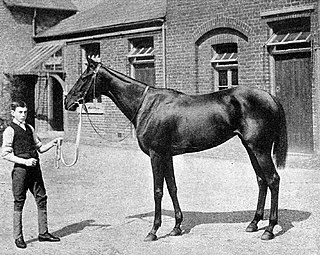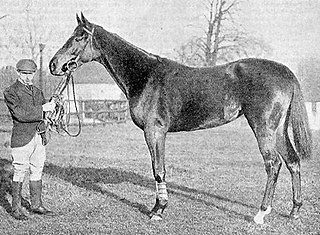
Keystone was a British Thoroughbred racehorse and broodmare. Having suffered from ill-health as a juvenile she recorded an emphatic win in the Epsom Oaks on her second racecourse appearance. She went on to win the Coronation Stakes and three other races as well as finishing second in the Jockey Club Stakes and a possibly unlucky fourth in the St Leger. She failed to win in the following year and was retired from racing. As a broodmare she produced the St Leger winner Keysoe and was the female-line ancestor of Display and Ballymoss.

Tranquil was a British Thoroughbred racehorse and broodmare. She showed considerable promise as a two-year-old when she won one race and finished second in the Gimcrack Stakes. In the following season she was one of the best horses in Britain, scoring classic victories in the 1000 Guineas and St Leger Stakes as well as winning four other races including the Jockey Club Cup and Newmarket Oaks. She won once in 1924 before her racing career was ended by injury. She made no impact as a broodmare.
Campanula was a British Thoroughbred racehorse and broodmare. In 1933 she won two of her five races including the Windsor Castle Stakes and the Moulton Stakes and was rated the best juvenile filly in England. In the following spring she won the Column Produce Stakes and then recorded her biggest win in the 1000 Guineas. In her two subsequent races she finished fourth in the Epsom Oaks and second in the Champion Stakes. As a broodmare she exerted an enduring influence as a broodmare through her daughter Calluna.

Aida was a British Thoroughbred racehorse and broodmare. As a juvenile she finished second on her debut and then defeated the future Epsom Derby winner Volodyovski in the Imperial Produce Stakes. She won the 1000 Guineas on her first appearance of 1901 and then finished a close third in a very strong edition of the Newmarket Stakes. She finished unplaced in the Eclipse Stakes and the St Leger and was retired from racing at the end of the year. As a broodmare she had an enduring influence on the breed through her daughter Herself.

Winifreda was a British Thoroughbred racehorse and broodmare. After winning the Richmond Stakes on her only start as a juvenile she took the 1000 Guineas on her three-year-old debut. She disappointed when favourite for the Epsom Oaks but returned to form to win the Coronation Stakes at Royal Ascot. Her career was then interrupted by health problems and she was well beaten in two subsequent races. She made no impact as a broodmare.

Sibola (1896–1921) was an American-bred, British-trained Thoroughbred racehorse and broodmare. She was sent to England as a yearling and showed some promise as a two-year-old in 1898 although she failed to win a race. In the following year, she was the most successful filly of her age in England, taking the Wood Ditton Stakes, 1000 Guineas, Derby Biennial Foal Stakes and Scarborough Stakes as well as finishing a close and unlucky second in the Epsom Oaks. She remained in training until the age of five but never recovered her best form. As a broodmare she had an enduring influence on the breed as the female-line ancestor of Nearco.

Nun Nicer (1895–1915) was a British Thoroughbred racehorse and broodmare. As a two-year-old in 1897 she ran consistently, winning three of her nine races including the Manchester Summer Foal Plate and Hopeful Stakes as well as being placed on four occasions. In the following year she won the 1000 Guineas, Triennial Stakes, September Stakes and Palatine Plate and finished second in the Epsom Oaks and Coronation Stakes. As a four-year-old she ran second in the Stewards' Cup and won the Preis von Donausschingen in Germany. She made no impact as a broodmare.

Chelandry (1894–1917) was a British Thoroughbred racehorse and broodmare. She was the top-rated juvenile filly in England in 1896 when she won the Woodcote Stakes, Great Surrey Breeders' Foal Plate, National Breeders' Produce Stakes and Imperial Produce Stakes. In the following year she won the 1000 Guineas and finished second in both the Epsom Oaks and the St Leger. She remained in training as a four-year-old but failed to win again and was retired at the end of the year. After her retirement from racing, she became an exceptionally successful and influential broodmare.
Thais (1893–1898) was a British Thoroughbred racehorse and broodmare. She showed very promising form as a juvenile in 1895 when she was placed in the New Stakes and the July Stakes before winning the Crabbet Plate at Gatwick. In the following year she won the 1000 Guineas and finished second in both the Epsom Oaks and the Coronation Stakes before being retired at the end of the season. She had no chance to prove her worth as a broodmare, dying at the age of five without producing a foal.
Canterbury Pilgrim (1893–1917) was a British Thoroughbred racehorse and broodmare. She showed some ability as a juvenile but failed to win a race. She won the Oaks Stakes on her first run as a three-year-old and went on to win the Liverpool Summer Cup, Park Hill Stakes and Jockey Club Cup before being retired at the end of the year. As a broodmare the best of her offspring was Swynford, a top-class racehorse who was even better as a breeding stallion. She also produced the influential sire Chaucer and several good broodmares. She has been described as "one of the most influential horses, stallion or mare, of the Twentieth Century".

Musa was a British Thoroughbred racehorse and broodmare. As a two-year-old in 1898, she failed to win but showed great promise by being placed in several major races including the New Stakes. In the following spring, she finished third in the 1000 Guineas before winning the Epsom Oaks. She ran unplaced in two subsequent starts and was retired from racing at the end of the year. She had considerable success as a broodmare.

Airs and Graces was a British Thoroughbred racehorse and broodmare. As a two-year-old she raced in the colours of the 6th Duke of Portland and showed modest ability, winning one minor race. After being bought by the Australian sportsman W T Jones she showed much improved form at three in 1898, winning the Epsom Oaks and being placed in both the 1000 Guineas and the Coronation Stakes. She failed to win a race in 1900 but ran well to finish second in the Cambridgeshire Handicap. She was exported to France to become a broodmare and produced two top-class winners.

Limasol (1894–1916) was a British Thoroughbred racehorse and broodmare. She showed promising form as a two-year-old despite failing to win any of her three starts and recorded her biggest success on her three-year-old debut when she upset the odds-on favourite Chelandry to take the Epsom Oaks. She was subsequently campaigned over extreme distances against male opposition and never won again. She made no impact as a broodmare.
La Sagesse was a British Thoroughbred racehorse and broodmare. She was highly tried as a juvenile in 1894, winning six of her thirteen races including the Newmarket Breeders' Plate and the Fitzwilliam Stakes. In the following year she finished second in the 1000 Guineas before recording her biggest victory in the Oaks Stakes and then running third under top weight in the Coronation Stakes. She remained in training until the age of five, competing against male opposition in valuable handicap races. She won the Derby Cup in 1896 and ran third in the City and Suburban Handicap in 1897.

Mrs Butterwick was a British Thoroughbred racehorse and broodmare. She spent most of her racing career competing in sprint races but recorded her biggest victory over a distance of one and a half miles when she won the Oaks Stakes in 1893. She showed good form as a two-year-old, winning three races and finishing second against older horses in the July Cup. In the following year she began her campaign with a defeat over five furlongs before being stepped up in distance for her upset win in the Oaks three days later. She spent the rest of her career competing in handicap races and won at least twice under big weights in 1894. After her retirement from racing she had considerable success as a dam of winners.
Mimi was a dual classic-winning British Thoroughbred racehorse and broodmare. As a two-year-old in 1890 she showed very promising form to win her first four starts but was well beaten when stepped up in class to contest the Middle Park Plate and the Dewhurst Plate. She established herself as the best filly of her generation in May 1891 with three wins in 26 days, taking the 1000 Guineas over one mile, the Newmarket Stakes over ten furlongs and the Oaks Stakes over 1+1⁄2 miles. She was subsequently beaten in the Prince of Wales Stakes at Leicester and was no match for Common in the St Leger. She was retired from racing at the end of the year and went on to have some success as a dam of winners.

Memoir was a dual classic-winning British Thoroughbred racehorse and broodmare. As a two-year-old in 1889 she showed considerable promise as she won the last three of her six races. In the following spring she appeared an unfortunate loser when stable arrangements prevented her from beating Semolina in the 1000 Guineas but she went on to win the Newmarket Stakes, Oaks Stakes, Nassau Stakes, St Leger and Newmarket Oaks. She added a win in the July Cup before being retired at the end of 1891. Although she produced no major winners, she had an enduring influence through her daughter, Miss Gunning.
Throstle (1891–1910) was a British Thoroughbred racehorse and broodmare. Born partially blind and considered a likely candidate for euthanasia as a foal she nevertheless proved herself one of the two best fillies of her generation in Britain. She showed considerable promise despite failing to win in three starts as a juvenile in 1893 and began her second season by running sixth to Amiable in the 1000 Guineas. In the summer of her second season she made rapid progress, winning the Coronation Stakes and Nassau Stakes as well as finishing fourth against very strong male opposition in the Eclipse Stakes. Poor form in training led to her starting at odds of 50/1 for the St Leger but she created a huge upset by defeating the Epsom Derby winner Ladas. She failed to win again and was retired from racing in 1895. She had little success as a dam of winners.
Galeottia was a British Thoroughbred racehorse and broodmare. She ran consistently well against high-class opposition as a two-year-old in 1894 although she won only one of her seven races. The filly reached her peak in the first half of 1895 when she won the 1000 Guineas and finished second in the Oaks Stakes but did not win any further major races. She had some success as a broodmare especially through her daughter Gay Laura, who produced the English Triple Crown winner Gay Crusader.
Reve d'Or was a British Thoroughbred racehorse and broodmare who won two British Classic Races in 1887. She ran nine times as a juvenile in 1886, winning three races including an upset victory in the Dewhurst Plate in October. In the following year she won nine races including the 1000 Guineas, Oaks Stakes, Sussex Stakes, York Queen's Plate, Yorkshire Oaks, Great Foal Stakes and Newmarket Oaks. She remained in training until the age of seven, winning the Jockey Club Cup in 1888 and the City and Suburban Handicap in 1890. She had limited success as a broodmare in France.












